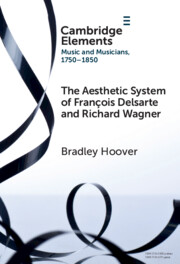Refine search
Actions for selected content:
26 results
Chapter 16 - Richard Wagner
- from Part V - Schoenberg’s Others
-
-
- Book:
- Schoenberg in Context
- Published online:
- 04 September 2025
- Print publication:
- 04 September 2025, pp 165-173
-
- Chapter
- Export citation
Chapter 8 - Schoenberg the Theorist
- from Part II - More than a Composer
-
-
- Book:
- Schoenberg in Context
- Published online:
- 04 September 2025
- Print publication:
- 04 September 2025, pp 76-85
-
- Chapter
- Export citation

The Aesthetic System of François Delsarte and Richard Wagner
- Catholicism, Romanticism, and Ancient Music
-
- Published online:
- 07 April 2025
- Print publication:
- 08 May 2025
-
- Element
- Export citation
Concert Hall Music Drama: From London to Bayreuth and Back Again
-
- Journal:
- Cambridge Opera Journal / Volume 36 / Issue 1 / March 2024
- Published online by Cambridge University Press:
- 16 December 2024, pp. 69-92
-
- Article
-
- You have access
- Open access
- HTML
- Export citation
5 - Finding an Ending
-
- Book:
- The Theological Imagination
- Published online:
- 09 November 2024
- Print publication:
- 07 November 2024, pp 127-160
-
- Chapter
- Export citation
Chapter 11 - Wagner, Schopenhauer, and the World as a Phantasmagoria
- from II - People
-
-
- Book:
- Wagner in Context
- Published online:
- 14 March 2024
- Print publication:
- 14 March 2024, pp 113-121
-
- Chapter
- Export citation
Chapter 34 - Historic Stagings: 1876–1976
- from V - Music and Performance
-
-
- Book:
- Wagner in Context
- Published online:
- 14 March 2024
- Print publication:
- 14 March 2024, pp 340-352
-
- Chapter
- Export citation
Chapter 32 - Wagner on the Move
- from V - Music and Performance
-
-
- Book:
- Wagner in Context
- Published online:
- 14 March 2024
- Print publication:
- 14 March 2024, pp 321-330
-
- Chapter
- Export citation
Chapter 40 - Wotan’s Stormtroopers and the Total Art Machine: Kittler’s Ring of the Nibelung
- from VI - Reception
-
-
- Book:
- Wagner in Context
- Published online:
- 14 March 2024
- Print publication:
- 14 March 2024, pp 399-411
-
- Chapter
- Export citation
Chapter 10 - Nietzsche and Wagner: The Logic of Contradiction
- from II - People
-
-
- Book:
- Wagner in Context
- Published online:
- 14 March 2024
- Print publication:
- 14 March 2024, pp 104-112
-
- Chapter
- Export citation
20B - Antisemitism in Modern Literature and Theater
- from Part III - The Modern Era
-
-
- Book:
- The Cambridge Companion to Antisemitism
- Published online:
- 05 May 2022
- Print publication:
- 02 June 2022, pp 367-376
-
- Chapter
- Export citation
9 - From Heaven and Hell to the Grail Hall via Sant’Andrea della Valle
-
-
- Book:
- Italian Opera in Global and Transnational Perspective
- Published online:
- 17 March 2022
- Print publication:
- 24 March 2022, pp 167-191
-
- Chapter
- Export citation
14 - Between ‘Sung Theatre’ and Asakusa Opera
-
-
- Book:
- Italian Opera in Global and Transnational Perspective
- Published online:
- 17 March 2022
- Print publication:
- 24 March 2022, pp 278-297
-
- Chapter
- Export citation
Chapter 22 - Brecht’s Work with Musical Composers
- from Part II - Brecht’s Work
-
-
- Book:
- Bertolt Brecht in Context
- Published online:
- 28 May 2021
- Print publication:
- 10 June 2021, pp 191-198
-
- Chapter
- Export citation
Chapter 5 - Brecht and Music: The Fly in the Amber
- from Part I - Brecht’s World
-
-
- Book:
- Bertolt Brecht in Context
- Published online:
- 28 May 2021
- Print publication:
- 10 June 2021, pp 49-56
-
- Chapter
- Export citation
Chapter 4 - The Problem of the Wagnerian Hero
-
- Book:
- E. M. Forster and Music
- Published online:
- 22 April 2021
- Print publication:
- 27 May 2021, pp 103-131
-
- Chapter
- Export citation
Chapter 21 - The Orchestra
- from Part IV - Professional and Musical Contexts
-
-
- Book:
- Richard Strauss in Context
- Published online:
- 08 October 2020
- Print publication:
- 29 October 2020, pp 191-199
-
- Chapter
- Export citation
Chapter 11 - Bayreuth
- from Part II - Career Stations
-
-
- Book:
- Richard Strauss in Context
- Published online:
- 08 October 2020
- Print publication:
- 29 October 2020, pp 96-104
-
- Chapter
- Export citation
Chapter 15 - Antiquity
- from Part III - Cultural Engagement and Musical Life
-
-
- Book:
- Richard Strauss in Context
- Published online:
- 08 October 2020
- Print publication:
- 29 October 2020, pp 137-144
-
- Chapter
- Export citation
14 - The Ring in Cinematic and Popular Culture
- from Part IV - Impact
-
-
- Book:
- The Cambridge Companion to Wagner's Der Ring des Nibelungen
- Published online:
- 18 September 2020
- Print publication:
- 24 September 2020, pp 317-336
-
- Chapter
- Export citation
